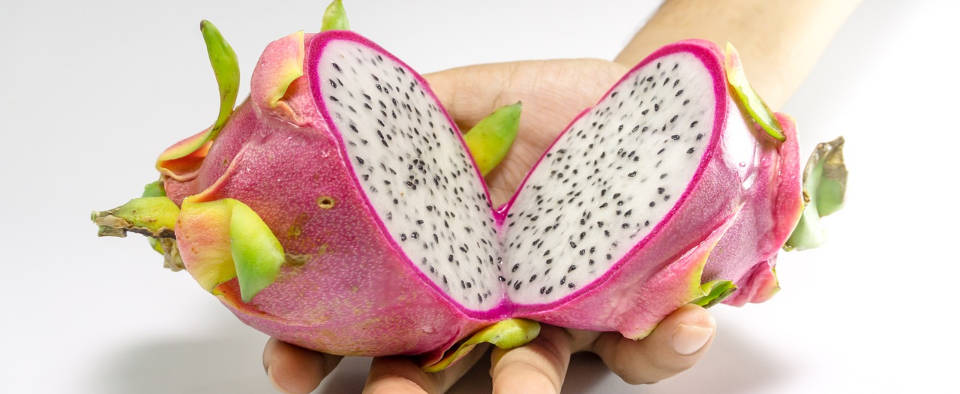What is Dragon Fruit?

Does it breathe fire? Are all dragon fruit controlled by Daenerys Targaryen from Game of Thrones? Does it kill Dwarves, steal their gold and jewels and then take up residence in their mountain kingdom?
Obviously not since a dragon fruit is an inanimate object. However, many of us know more about mythical dragons than we do about the very real dragon fruit. Well, this post is written to rectify that unfortunate fact.
A dragon fruit is, first and foremost, just that, a fruit. It is spherical in shape (about the size of a softball) with bright red skin and green scales that look like they came off a dragon…hence the name.
Also known as a strawberry pear, they are the fruit from the tropical Hylocereus cactus which is native to Mexico and Central America, and they are now grown across the globe, from Southeast Asia to the American Southwest. Dragon fruit can now be located in grocery produce areas throughout the country and a ripe dragon fruit is slightly soft, but not mushy-soft.
Their flesh is white and contains hundreds of tiny black seeds, similar to the kiwi fruit and the taste has been described as a cross between a kiwi and a pear. To access the flesh, simply cut the dragon fruit lengthwise and scoop it out with a spoon or melon baller. Or, cut vertical and horizontal lines in the flesh, creating cubes without cutting the skin. Then simply separate the skin from the flesh and pull the cubes off with your fingers or cut them free with a knife. This method is also used to separate the flesh of a mango from its skin. Dragon fruit flesh works well in salads (veggie or fruit), smoothies, yogurt or just eat it plain as a snack. Its juice also works well in cocktails, such as the “dragotini.”
What makes the dragon fruit special, however, is its nutritional value, especially the antioxidants contained within. The dragon fruit is one of the few fruits that provides a good source of iron, which aids the blood in transporting oxygen to the muscles. It is also a good source of prebiotic fiber, as opposed to probiotic fiber found in many yogurts.
Your digestive system cannot digest fiber without the assistance of beneficial bacteria found in our gut and prebiotic fiber supports the growth and well-being of that beneficial bacteria. It can also reduce the risk of digestive tract infections and cases of diarrhea. Lastly, in terms of traditional nutrients, dragon fruit contains a fair amount of magnesium which helps breakdown food into energy, muscle contractions and bone formation.
As for the antioxidants contained within dragon fruit, they include betalains which are linked to lower cholesterol and hydroxycinnamates which has been shown to fight certain cancers. Dragon fruit is also a great source of flavonoids which supports brain health and can reduce the risk of heart disease. The antioxidants beta-carotene and lycopene, which give the dragon fruit its distinctive colors, can also reduce the risk of certain cancers and heart disease. One last thing, dragon fruit are quite low in calories with one cup containing only 60 calories.
In essence, this post could be summed up in a single sentence: “Dragon fruit are referred to as a nutrient rich food, one low in calories and high in nutritional value.” (The “dragotini” thing is just an additional benefit). And since it has a palatable taste, there’s no reason not to go looking for Smaug (The Hobbit), Drogon, Rhaegal, and Viserion (three from Game of Thrones) in the produce section of your local grocery store or Whole Foods.
You must be logged in to post a comment.